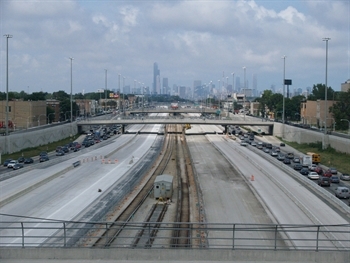
Flickr user cta web (cc)
The Wells Street Bridge under construction in March.
Published monthly, MPC’s Talking Transit provides updates about transit-related activities around the world.
Get In the Loop on all the latest local, national and international transit headlines. >>
Did You Know? Since 1995, use of the Chicago region’s public transportation system has grown by 25 percent. More than 80 percent of that growth has occurred on Chicago Transit Authority (CTA) El lines, with ridership practically doubling.

Talking Transit is supported by Bombardier.
But the CTA rail system is aging. “Slow zones,” where trains are forced to creep at a snail’s pace because of old track, account for 15.5 percent of the system, resulting in longer travel times and less reliable service for commuters. Fortunately, the CTA has the funding to improve the most challenged sections of its rail system and has taken a new approach to construction: speed. In the past, the agency has been reluctant to shut down service; as a result, recent Pink and Brown Line renovations each took more than three years to complete. Now, however, the CTA is taking a new approach: shutting down lines entirely, which inconveniences riders in the short term but produces a quicker and cheaper result.
Wells Street Bridge
The city demonstrated the new approach with the renovation of the Wells Street Bridge, a double-decker road and transit facility that crosses the Chicago River from the city’s North Side neighborhoods into the Loop. The 500-ton bridge, built in 1922, needed work: Salt corrosion and weather-related wear-and-tear necessitated its renovation or replacement. But renovating a bridge that carries 77,000 daily Brown and Purple Line transit users without shutting it down would, under normal circumstances, take years.
So the city decided to prefabricate a replacement structure in two parts off-site, remove the north and south halves of the bridge individually, and “slide” the new structure in place.
Over the course of two nine-day stretches, the CTA shut down train service on the bridge, requiring transit commuters to rethink their commutes by switching to a bus shuttle or alternative rail lines. Riders complained that crowding increased on other lines. But CTA communicated frequently with travelers and kept them aware of alternative routes, which minimized the public outcry.
There was a big payoff: a cheaper construction bill, a quick return to normal operations and a new bridge in good repair. Quicker construction time saved taxpayers an estimated $500,000. Moreover, while transit riders suffered for a total of two working weeks, they benefitted from an improved and safer structure much more quickly than if the bridge had been rebuilt in place.

The Red Line section being renovated runs in the median of the Dan Ryan expressway.
Flickr user Steven Vance (cc)
Red Line South
The roughly 300-foot-long Wells Street Bridge replacement was minor in comparison with the reconstruction of the 10.2-mile southern portion of CTA’s Red Line, which runs in the median of the Dan Ryan Expressway. The project, which affects nine stations from 95th Street to Cermak-Chinatown, requires a five-month transit shutdown, with reopening scheduled for October.
The Red Line reconstruction is expected to cost $425 million in local and state grants, and affects 80,000 daily riders. It addresses long-ignored maintenance problems on a rail line that opened in 1969 and has seen little improvement since. Just before the project began, 3.3 miles of the southbound track was limited to 15 mph.
CTA will replace everything in the trackbed, including ties, rails, third rail, ballast and drainage. Once completed, the project is expected to significantly improve travel times, decreasing the currently half-hour-long journey from 95th Street to Roosevelt by more than a third, to under 20 minutes. It will also improve reliability and reduce operations costs.
For riders who rely on the Red Line, the shutdown is difficult. In the 1990s, the CTA shut down service on the Green Line for two years; though service improved, ridership declined. Certain community members have called for Red Line renovations to be conducted only on weekends. But CTA notes that weekend ridership is high, and a weekend-only construction project would take four years. Current plans will provide fast service by this fall, rather than in 2017.
Similarly, a weekends-only approach would have increased costs by an estimated $75 million because of the disruption caused by moving workers and materials in and out of the site weekly, in addition to higher overhead and cost inflation over time. The agency has designated a portion of those savings for station improvements, which will include upgraded canopies and lighting, in addition to the installation of elevators at three stations.
CTA has planned extensively for the conveyance of Red Line users during the disruptions. Red Line trains have been rerouted to the parallel Green Line (expected to see a four-fold increase in ridership); area bus routes have received increased service and lower fares; and free shuttle buses connect Red Line stations to the Green Line. In addition, Metra is offering benefits to CTA riders who switch to its commuter trains. Other transit service providers also have increased service, including the Chicago Water Taxi.
A New Precedent?
Chicago’s reconstruction program suggests that the shutdown of a rail line during renovations provides a number of benefits. These projects can be completed more quickly, and for less money, than the alternative that keeps the line open. In an era with limited public funds, that’s a big benefit—particularly when it is so important to emphasize the maintenance of our existing infrastructure. MPC’s proposals to prioritize State of Good Repair would ensure that maintenance issues are addressed quickly through the federal and state grant-making process.
The Chicago Transit Authority has several important upgrades to its systems in the works, including the modernization of the north section of the Red Line. That project will be even more costly and time-intensive than the Red Line South program, but the lessons learned from the projects profiled here may be useful in determining how best to conduct future improvements.